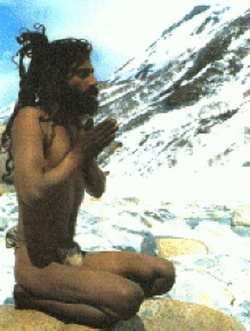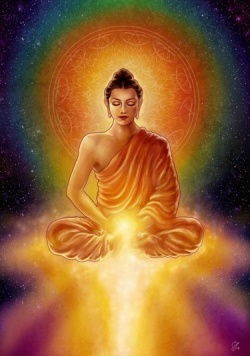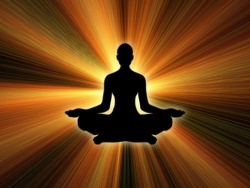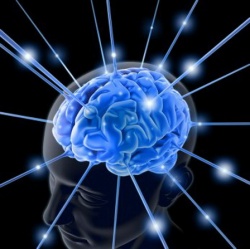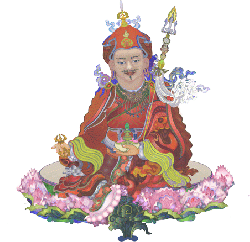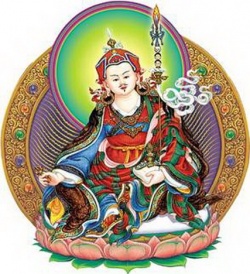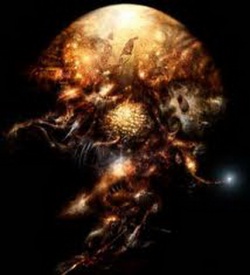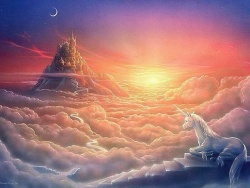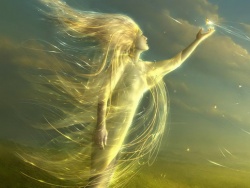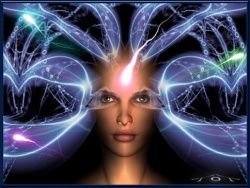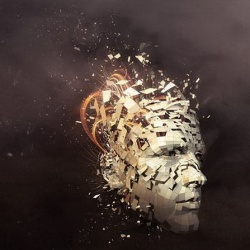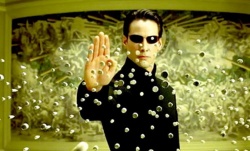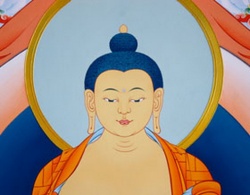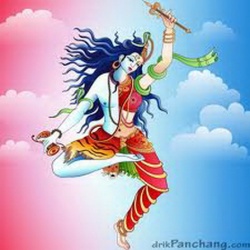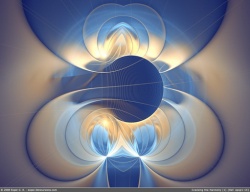Aspects of Buddhist Psychology
Aspects of Buddhist Psychology
Lecture 44: Psycho-spiritual symbolism in the Tibetan Book of the Dead
Mr Chairman and Friends:
Last week we reached a turning point in our course on Aspects of Buddhist Psychology. Up to last week, we had been addressing, we may say, the conscious Mind. Whether in the lecture on the Analytical Psychology of the Abhidharma or the Depth Psychology of the Yogacara, we were addressing the conscious Mind and using therefore what we may describe as the Language of concepts, the Language of abstract ideas, abstract Thought.
It was only last week that we started addressing, started trying to speak to, started to penetrate to, if possible, the Unconscious Mind. And therefore we started using the Language of images, the Language of myth, of legend, of poetry and so on. And we started also exploring, last week, what we may describe as the archetypal World. And we studied some of the archetypal symbols which occur in the biography, the so-called "legendary" Life, of The Buddha.
Now today we are continuing that exploration, but we are continuing it within a rather different context. Last week we studied the archetypes, the archetypal symbols in the context of the so-called legendary Life of The Buddha. Today we are studying them within a quite different context: we are studying them within the context of Death.
This evening our subject is the psycho-spiritual symbols of the Tibetan Book of the Dead. Now Death, we may say, is not a very popular subject. I was going to say that people don't exactly come flocking to a lecture on Death - but it seems that that is just what they do! I must admit that I have sometimes been rather surprised. I remember a couple of years ago when I gave a series of fortnightly lectures at Kensington over a whole year, on various aspects of Buddhism, the biggest attendance was when we had a lecture on "Buddhism and the problem of Death". Then they really did turn up, I won't say in their hundreds, but certainly the room was packed. I think so far as Kensington was concerned on that particular occasion, it was probably because we had in the neighborhood rather a large number of spiritualists. It might also have been because quite a number of people do find Death a bit of a problem - but it is, after all, a problem which we all have to face sooner or later.
We have sometimes lectures on Meditation - well, sometimes people are not all that interested in Meditation - you don't have to meditate. They may not be all that interested in Buddhist Philosophy - you don't have to study that - and even in Buddhist psychology, even in aspects of Buddhist psychology, they may not be particularly interested in that subject, either - but you can hardly help being interested in Death. A human being can hardly help being interested in Death - at least, so much one would have Thought. But we do find, unfortunately, that here in the West, very often people are rather reluctant to face up to the fact of Death. And in some circles it seems to be considered even rather indecent to refer too openly or too bluntly to this fact of Death.
It is perhaps significant that in this country, in the English Language, we have quite a large number of euphemisms for Death. For instance, instead of saying that someone has just died, bluntly and crudely like that, we tend to say "Well, he's passed away", or even, "passed on", or again even, "passed over". Or we sometimes say, "He is no more." We put it as indirectly as that. And some people, I have even heard say, "He has gone to his heavenly home." Others merely say, "Gone away" or "been called away" but we have all these various euphemisms for this plain and simple fact of Death - it's as though people don't like to pronounce this word - don't like to say that so and so is just - dead.
And this reluctance to face up to, to recognize the fact of Death, we may say is due basically, simply, to fear. We just don't want, really, to die. So very often we pretend, or we try to pretend, that we won't die. We just ignore that fact, we just shut it out of our minds, we force it into the background of our Consciousness, where it lurks all the time, ever ready to spring out, as it were, but always kept in the background, in the shadows, not recognized, much less still accepted.
But in the East, I would say, broadly speaking, as compared with the West, we do not find this state of affairs. In the East, I would say, having lived there for some twenty years, I would say that Death was accepted much more easily, much more readily, than in this country, in the West generally. One might even go so far as to say that sometimes or even very often, in the East, people look forward to Death - quite ordinary people - not saints, and sages and yogis and Mahatmas, but quite ordinary people - look forward to Death. They even look forward to old age. In Buddhist countries, people look forward to old age very often with positive enjoyment because they think their children and their grandchildren will be grown up, they won't have very much to do, no household affairs to look after, they just grow old gracefully, accumulate Merit and look forward to dying.
In Chinese Buddhist circles, for instance, they order their coffins well in advance, have beautifully carved and lacquered ones, and keep it in state, as it were, in the sitting room. And when a friend comes to tea or just to see them, they take them into the sitting room and say, "Look, my coffin. Magnificent teak - isn't it lovely? This is what I'm going to be buried in." And they're quite happy and quite pleased about it all. So this tends to be the Eastern attitude.
I recollect in this connection there's a poem by the great Indian poet Rabindranath Tagore in the course of which he says, "I know I shall Love Death, because I have loved Life." And this is indeed the Eastern attitude; this is a typical expression of the Eastern attitude: to Love Death because you have loved Life. You see, you recognise, you accept that Life and Death are two aspects of the same thing: two sides of the same coin. So that if one loves one, one can hardly help, one can hardly avoid loving the other also.
Now in Buddhism, which historically is an Eastern Religion, an Eastern spiritual tradition, very great attention indeed is paid to this question of Death. And Buddhists of whatsoever school are exhorted all the time to be mindful of the inevitability of Death - to remember all the time in the midst of Life, in the midst of youth, in the midst of health, in the midst of pleasure - to be mindful, to recollect, that one day, one will be no more. One day, one will come face to face with this fact, with what appears to us almost a terrible reality, of Death.
Those of you who have attended the Meditation classes, those of you who have heard perhaps, some of the talks I have given on Meditation, will remember that recollection of Death - being constantly mindful of one's inevitable end, at least of the physical Body - is one Form of one of the five basic methods of Meditation, designed to cure us of the disease, the sickness, of Craving.
In Buddhism generally, in Buddhist teaching, Buddhist tradition, there are many teachings on this subject of Death. If you look through Buddhist literature, you will find that there is quite a big literature simply on this subject of Death. One might even say, a vast literature, in various languages, canonical and non-canonical. But we may say also that there is one source, one literary source on the subject of Death in Buddhism which stands out above all others, which as it were synthesizes the whole of the Buddhist teaching on the subject of Death. Not only synthesizes, but adds, we may say, unique esoteric elements of the highest value. And this source, this text, is the one with which we are concerned today, that is to say, the Tibetan Book of the Dead.
Now this is not its real title - it's a very good title, a very expressive one; this is exactly what it is, in a way, the Tibetan Book of the Dead - but its real title in Tibetan is Bardo Thodol. What that means, we shall see a little later on. Meanwhile, we shall continue to refer to this work as the Tibetan Book of the Dead.
Now what is the origin of this work? What is its source? Where did it come from? If not in its present literary Form, at least insofar as its contents and teachings are concerned, the Tibetan Book of the Dead goes back to one of the greatest figures in the whole history of Buddhism, also we may say, one of the most interesting, fascinating and colourful figures in the whole history of Buddhism, and that is the great Guru Padmasambhava.
I don't know how many of you have heard of him, but perhaps it is a measure of one's Knowledge and understanding of Buddhism - The History of Buddhism, at least - whether one has heard of and appreciates the Life of this great figure, Padmasambhava, the Lotus-born Guru.
Padmasambhava was a great Indian teacher of the Eighth Century of the Common Era. He was a very great scholar, a great sage, a great Philosopher, mystic, yogi, and above all, according to tradition, a perfect master of all the occult sciences and all the esoteric traditions. Many students of Buddhism believe that he was the greatest master in this field next to The Buddha himself, who has ever lived. It was this great teacher, Padmasambhava, who above all others was responsible for the initial establishment of Buddhism in Tibet. And he is regarded, or afterwards became, the founder of the Nyingmapa School of Tibetan Buddhism. This is the oldest school of Tibetan Buddhism going right back to Indian origins, Indian traditions. Sometimes it's referred to as the Red Hat or Red Cap School because the initiates of this sect when performing certain ceremonies, wear red conical hats instead of yellow ones like the Gelugpas.
Now Padmasambhava, the Lotus-born Guru, or Guru Rimpoche, as the Tibetans call him, is regarded by all his followers in Tibet and the whole Himalayan region, as the second Buddha, and this will give one some measure of his greatness and his importance. I would in fact like to say very much more about him, but there is no time at present. Perhaps one day it may be possible for me to give one complete lecture on his Life, his career, his teachings and so on.
Now according to tradition, when Padmasambhava established Buddhism in Tibet, when he established what afterwards became the great Nyingmapa tradition, he saw that there were many teachings, more subtle, more Esoteric teachings, for which the Tibetans were not then prepared. He felt, "It's no use giving them these teachings now: they won't appreciate them, they won't be able to understand them." So according to tradition, he wrote down in book Form many ancient teachings, many esoteric traditions, and these Books he hid away in different parts of Tibet, in fact different parts of the whole Himalayan area, in Caves and other such places. And we are told that in the course of centuries, these texts - or at least, some of them - were eventually discovered. Many texts, we are told, have not yet been taken out, have not yet been discovered.
These texts are known technically in Tibetan as termas. Terma literally means 'that which is taken out', or in other words, a treasure. And there is in Tibetan literature, a complete collection of all these works supposedly written centuries ago by Padmasambhava, and subsequently taken out in different parts of Tibet at different times by different yogis, by different teachers, and made available. At present the collected edition of these termas comprises some sixty-four volumes. These sets by the way are very, very rare. I myself have only seen one twice; once in Gangtok and once in Kalimpong. In Gangtok the Maharajah of Sikkhim has a set and in Kalimpong one of my own teachers has a set. So far as I know, in the west, there is only one set and that is at Rome, with Professor Tucci. So far as I know there is no other set at all in the West.
Now the Nyingmapas, the followers of Padmasambhava, regard the Rinchen Terma, as they call this collection, as canonical and as equal in authority to the Scriptures in the sense of the word of The Buddha himself. Now the Tibetan Book of the Dead, with which we are concerned this evening, is one of these termas, and the text was discovered, or taken out, by a great teacher called Rinchen Karmalingpa. And so far as we know (traditions are rather hazy) he lived and took out this text in the 13th or the 14th Century.
Now, as I've said, the Tibetan Book of the Dead is not the real title of this work. This title was given by Dr Evans-Wentz, who was the editor of Kazi Dawa-Samdup's English translation of the Bardo Thodol. He gave this title, the Tibetan Book of the Dead, on analogy with the Egyptian Book of the Dead which had been translated from Egyptian hieroglyphics some years earlier by Sir Wallace Budge. The real title of this work is the Bardo Thodol.
Incidentally, I might observe at this point that Tibetan literature, Tibetan tradition, attributes a very large number of prophecies to Padmasambhava. One of my friends in Kalimpong once told me that one of his teachers in Tibet had read out to him a prophecy attributed to Padmasambhava which went like this: "When the iron birds fly in the sky, my teaching will go to the West." This is supposed to have been the prophecy of Padmasambhava. Well, we all know what the iron birds are, but it certainly does seem as though the prophecy has been fulfilled in the case of the present work, the Tibetan Book of the Dead or the Bardo Thodol.
The English translation was first published in 1927, quite a long time ago, and has attracted in the West a very great deal of attention. Amongst others, it attracted the attention of the great psychologist Jung, who wrote about it in his psychological commentary on the Tibetan Book of the Dead published in the Third Edition of the translation: "For years, ever since it was first published, the Bardo Thodol has been my Constant companion, and to it I owe not only many stimulating ideas and discoveries, but also many fundamental insights." Now this is the testimony of Jung, whom many people regard as the greatest psychologist that the West has produced, certainly in this century.
Now what is the meaning of this title, Bardo Thodol? To take the second word first, Thodol literally means Liberation or emancipation by hearing. Bardo literally means between two: bar is between; do is two. So Bardo means between two, or if you like, more colloquially, in between. So this is why the word Bardo is usually rendered 'the intermediate state', because an intermediate state is a state in between two other states. So in this sense, Bardo corresponds to the Sanskrit antara-Bhava; antara meaning in between or inner, and Bhava meaning simply state.
Now according to the original Indo-Tibetan tradition, there are six bardos or six intermediate states. But before going on to describe these, I want to go just a little into the general principle underlying the whole Bardo teaching, including that of the Tibetan Book of the Dead.
I must emphasise that this is one of the most profound and important aspects of the whole Buddhist teaching, and to the best of my Knowledge it has never been publicly expounded in the West before. To understand, we must go back a little to something to which I have often referred before, to the teaching on the two types of conditionality. Those of you who come regularly will observe that all the subject matter, all the lectures, sort of link up, so that there's a Constant cross-reference. You may remember from the second lecture in this series there was some reference to the two types of conditionality, and the two types are, of course, the cyclical type of conditionality and the spiral type. The cyclical type is where you have an action and reaction between pairs of opposites, or these factors which are opposites; and the spiral type is action and reaction between factors which are not opposites, but which progressively augment; the succeeding augmenting the effect of the preceding factor instead of reacting from it to its opposite.
The first type of conditionality, the cyclical, action and reaction between opposites, is illustrated by the Tibetan Wheel of Life. The spiral type of conditionality is illustrated by the stages of the path, whether in terms of the twelve positive links, or Nidanas, or the twelve bodhyangas (Pali bojjhangas), or limbs or links of Enlightenment.
This evening we are concerned with the first of the two types of conditionality, with cyclical conditionality, and this is essentially a movement of action and reaction between factors which are opposites. We have many examples of this sort of process, for instance, this very natural process of breathing; breathing in, breathing out; an action and reaction between opposites. In just the same way, there is a reaction between hunger and satiety, action and reaction between sleeping and waking; a Constant alternation between these states, a cyclical type of conditionality.
And then again, Buddhism would say between, above all, Life and Death, or between birth and Rebirth, there also is an example of a cyclical type of conditionality, an action and reaction between factors which are pairs of opposites. Now so far as the individual human Life is concerned, this process of cyclical conditionality is set forth in detail in the Twelve Nidanas, or links, from Ignorance right down to old age and Death. The Twelve Nidanas are distributed over three lives; the past Life, the present Life and the future Life. And you'll also remember that the twelve links are distributed between what we call the cause process and what we call the effect process within this cyclical type of conditionality.
In this way, we have first of all the cause process of the past, consisting of two Nidanas, then the effect process of the present, consisting of five Nidanas; then thirdly, the cause process of the present, consisting of three Nidanas; and finally the effect process of the future, consisting of two Nidanas. We thus have an alternation of these two processes; cause process, effect process; cause process, effect process.
We have also three junctures; in other words, three points at which one process changes over into or is succeeded by the other. First, there is a point where the cause process of the past changes over into the effect process of the present. This is the moment of birth, or strictly speaking, the moment of conception. Secondly, the point where the effect process of the present passes over into the cause process of the present. Thirdly, the point where the cause process of the present changes over into the effect process of the future. This is the moment of Death and Rebirth.
Now the second of these three junctures is the most important from the point of view of general Buddhist teaching - the point where, in terms of the Twelve Nidanas, Feeling, or the last link of the effect process of the present Life, is succeeded by Craving, the first link of the cause process of the present Life. If one can stop this sequence, if one can prevent, in some way or other, Craving arising in dependence on Feeling, then one can stop the whole cause process of the present, and one can on the spot attain Liberation, as it were.
The spiral or path of the other type of conditionality winds out from this point. All this is shown on the chart from the second lecture. I have sketched this all rather rapidly because here we are really concerned with the underlying principle that there is a cyclic process, a movement of action and reaction between opposites, just like the swinging of a pendulum to and fro; action and reaction between all these different pairs of opposites.
But in between, there is a middle point: there is a point where the effect process ceases and the cause process has not yet begun. In other words, just for an instant, just for a fraction of a second, as it were, the pendulum has stopped, is at rest: there's no action; no reaction; there's a sort of knife-edge inserted here. It is at this point that we can make our escape, at that point where one process has ended and the other has not yet begun. Just at that point we can break through and find our way up the spiral into another dimension and this in principle, essentially, is the intermediate state, the antara-Bhava, the Bardo.
In other words we may say that the Bardo represents the point of transition within the cyclic process between the active and reactive phases where just for an instant, we are free from the cyclic process. And spiritual Life consists, if one considers it from this point of view, in being on the lookout, as it were, for such points, such moments, and taking advantage of them.
There are many such points, and the Indo-Tibetan Buddhist tradition distinguishes six such points as being of particular significance, and these six bardos are:
- the Bardo of Life
- the Bardo of dream
- the Bardo of Meditation
- the Bardo of the moment of Death
- the Bardo of Reality
- the Bardo of Rebirth.
This evening we are particularly concerned with the last three, the Bardo of the moment of Death, the Bardo of Reality and the Bardo of Rebirth, but I shall say a few words about each in turn.
1. The Bardo of Life
Life itself, according to this teaching, according to this tradition, is an intermediate state between birth and Death. It's also intermediate between the cyclic process and the spiral process; intermediate between the Wheel of Life and the path or the stages of the path, because it's in the course of this Life that we can decide, we can choose, we can make up our Mind, whether to continue to go round and round on the Wheel of Life or whether to go up and up in the spiral. Whether to be reactive, or whether to be creative. Therefore in all schools of Buddhism, very great importance is attached to human Life: human Life for Buddhism represents a great opportunity - a marvellous opportunity, because in this Life there is the possibility that one could attain this state of ultimate, of transcendental centrality which we call Buddhahood. And therefore this Bardo, this intermediate stage of Life, of human existence so rare and so valuable, according to Buddhism, should not be wasted.
2. The Bardo of Dream
The dream state is intermediate between the waking state and the deep sleep state. Or we can look upon it as intermediate between two waking states. In the dream state, it is possible to come in contact with deeper levels of reality, come in contact with these levels with the help of archetypal images. Here, of course, we are concerned not with ordinary Dreams. The images which come in these archetypal Dreams with which we are concerned now differ from ordinary Dreams in being brilliantly coloured, that's why they're very memorable, brilliantly coloured in all sorts of jewel like colours and hues, rainbow like and so on, and they're endowed for the person experiencing them with a great, an immense significance. Very often, after having had one of these, as it were, archetypal Dreams, experiences, when one wakes up one feels that something profound, something important, has happened; one feels changed; and one does not easily forget. Those who have studied Jung's psychology will know that Dreams of this sort play a very important part in what he calls the individuation process.
In Buddhism, there are many yogas of the dream state: spiritual exercises, methods of Meditation connected with or based upon the dream state. And very great progress can in fact be made in the dream state itself, in some cases, for some people, more easily and more quickly than in the waking state. One can even in the archetypal dream state receive teachings which one never forgets, and also even receive initiations of various kinds. According to tradition some have even gone so far as to attain Enlightenment itself in the dream state. We shouldn't think that Enlightenment can be attained only in the waking state: that's just our prejudice, making that our universal basis of operations.
No, Enlightenment can also be attained from the archetypal dream state. Most of these yogas of the dream state involve the prolongation of Mindfulness into the dream state so that when you're having these archetypal Dreams, you know that you are dreaming and that it is you dreaming. One is fully aware of the, as it were, reality of these states and experiences, but one's Mindfulness is not lost. There are various psychophysical methods of inducing Mindfulness in the dream state, so that one can even control one's Dreams and even have the sort of Dreams that one wants. But there's no time to go into detail this evening.
3. The Bardo of Meditation; the Dhyana Bardo
You might be surprised to find that Meditation is included here. In what sense is Meditation an intermediate state? It's, of course, intermediate between two states of so-called "normal" Consciousness. But more precisely, Meditation, from a certain point of view, is an intermediate state between two thoughts. Now what does this mean?
We are dominated by a Constant succession, an uninterrupted flow, a stream, a torrent, of thoughts. We're not usually conscious or aware of this. We become aware or begin to become aware at the time of Meditation. All those who have practiced Meditation know that as soon as you sit down, as soon as you close your eyes, you become aware of this great torrent of thoughts rushing past, and you have to struggle with this. But you watch it, you're aware of it, and gradually you find the torrent is slowing down: it doesn't seem to move as quickly: doesn't seem to rush quite so much; everything is going slower. You find a stage comes where one can see the whole process becoming more spaced out. You start becoming aware of each Thought individually, not just hundreds and thousands of thoughts all at the same time, but one Thought, as it were, coming at a time. And as the whole thing begins to slow down and as the thoughts start to come on their own, one begins, eventually, to experience the intervals between the thoughts.
There's a Thought, you are aware of it coming; you're aware of it staying; you're aware of it going; then there's no Thought: there's a space, a gap; no Thought. So you're aware of this, you experience it; then another Thought comes. So with practice, this sort of thing develops; these intervals lengthen. A Thought comes and goes, and it's a long time before another Thought comes. There's an interval of "Thought-lessness". At least for a little while, a few minutes; or it may be five minutes, or eventually, even half an hour, you experience a state of no Thought. So we may say that there is no real Meditation without this experience. It's only in this state of no Thought, in this empty space, as it were, between thoughts, that one can contact Reality.
These are the first three bardos - of Life, of dream and of Meditation, with which we are not so much concerned this evening.
Now we come to the last three bardos, with which we are really concerned this evening; the Bardo of the Moment of Death, the Bardo of Reality and the Bardo of Rebirth. It is with these three that the Tibetan Book of the Dead is mainly concerned. And in a sense they are all part of one single Bardo, in the sense that they are all intermediate between Death and Rebirth, or re-conception.
And this brings us to a rather important difference as between different schools of Buddhism. According to the Theravada tradition, Death is followed immediately by Rebirth, or re-conception. This instant, Death: the next instant, reconception. But all the other schools, the Sarvastivada and the Mahayana schools (the Chinese, Tibetan and Japanese schools) all hold that there is an interval; that the instant of Death is not immediately followed by the instant of reconception; there is an interval, a gap between them. According to the Tibetan Book of the Dead, this interval lasts for 49 days. The number is obviously symbolical: it's seven times seven, and it indicates that we're concerned here with a quite different time scale.
4. The Bardo of the Moment of Death
This is what the Tibetans call the Chikhai Bardo, and what does this mean? What happens at the moment of Death? We know of course that Consciousness is withdrawn from the senses; one no longer hears anything - sounds fade away; one no longer sees anything - everything is a sort of blur, and eventually no blur; no tactile sensations; no olfactory sensations; no taste; Consciousness is withdrawn from the five senses, from the physical Body and eventually of course, breathing itself ceases. One draws in one long, last Breath, and then, as it were, sighingly (the famous rattling the throat) exhales; then there is a long silence, and no further Breath is indrawn. And to those standing around it seems as though the person is Unconscious, in a sort of coma. At this point, at this stage, Consciousness is dissociated completely from all mundane things. Dissociated from the senses, from the lower Mind, from all the things one was interested in during Life, from all one's passions and attachments, one's likings and dislikings, and at that moment, according to the Tibetan Book of the Dead, an experience occurs.
At that moment, dissociated as one is from the senses, the lower Mind and all worldly things, one suddenly experiences, just for a flash, at least just for an instant, Reality itself - what the text calls the Clear Light of Reality. For a blinding instant, this dawns, and then disappears - what Buddhists call the Dharmakaya. For most people, it lasts just an instant, but in the case of others it lasts for a longer time. There's a basis for this, especially in the case of those who practice Meditation. But so far as most people are concerned, when at the time of Death, Reality is experienced in this way, it's not only instantaneous, it is even terrifying. Most people at this time feel intensely afraid of this glimpse, of this revelation, and they shrink back. They withdraw, they Retreat from it, because we may say the last thing that they want is Reality. They want anything - but not Reality. They can't face Reality. As T S Eliot said, "Humankind cannot bear very much Reality." It has in fact been suggested, I believe by Aldous Huxley, that our whole psychophysical organism is designed to protect and shield us from the impact, the onrush of Reality, to screen out Reality, so that we get it just in dribbles, as it were, and can assimilate it.
But, according to the Tibetan Book of the Dead, for those who do not shrink back, this moment or this experience represents a great opportunity. If one doesn't shrink back, if one is not afraid, if one accepts, then according to this teaching, at that moment one can as it were, unite oneself with that Reality. But in order to be able to do this, in order to be able in this, as it were, split second, or longer of the experience, one must recognize that Reality, one must recognise the Clear Light not as anything coming from outside, not as anything terrible, not as anything, as it were, breaking and bursting in: one must recognize the Clear Light as one's own; recognize it as the radiance of one's own True Mind at its deepest or at its loftiest level. This is one's own Mind, the Light, the Clear Light of one's own Mind, nothing from outside; the Light of the One Mind, which is one's own Mind, even as it is everybody else's Mind.
Now if, according to the Tibetan Book of the Dead, one has recognized the Clear Light of Reality in the course of one's earthly Life, perhaps say in Meditation or in some spontaneous Mystical experience, then recognition and even union at the moment of Death is easier. Because one, as it were, recognises an old friend, something that one has seen, experienced before. But it's still difficult at this moment because Death is an experience that, so far as we remember, has not befallen us before. We may be confused, as it were put off our stroke, so a little external help is necessary - a reminder, at least. So therefore it is prescribed that a Lama - that is to say, a spiritual teacher, or a brother in the Faith, should remind one at this moment, should be sitting by one's side at the time of Death and reminding you, quietly whispering in your ear that what you now see, what you now experience, this is Reality, this is the clear Light of Reality, your own Mind: "Don't be afraid, don't be terrified: allow yourself to be drawn to, be absorbed by that."
So this is why the full title of the work is the "Liberation by Hearing in the Intermediate State". One hears the advice, the reminder of the Lama or the spiritual brother, and one, as it were, recollects oneself, and one thinks, "Oh, yes, no need to be afraid, this experience of this Light is the Clear Light of my own Mind, let me unite with that." And especially if one has had any previous Meditative, Mystical experience it is more easy to unite at that time. So if one does unite, one is Liberated and all is well. One has attained Reality, emancipated from birth and Death and Rebirth. But if one doesn't recognize at this stage, if one is unable to grasp the experience, one experiences Reality a second time, there's a second experience, but this time, rather more obscurely.
This is what is known as the Secondary Clear Light. According to the Tibetan Book of the Dead, this dawns about half an hour after breathing has actually ceased. From this stage also, Liberation can be attained. But once again, a Lama or a brother in the Faith must remind one of one's spiritual practices during one's lifetime, saying "Don't forget," - as you are addressing the corpse - "Don't forget your meditations, your experiences in Meditation: what you are experiencing now is the same kind of thing. What you are experiencing now is what you experienced then, so don't be afraid, allow yourself to be drawn, allow yourself to unite." So in some cases, Liberation occurs at this stage. But in many, it doesn't, and those who are not Liberated, either by seeing the Primal Clear Light of Reality, or the Secondary Clear Light of Reality, fall into a deep swoon, a coma, an Unconscious state which lasts some three or four days. They go on to the next Bardo state, the Bardo of Reality or the Chonyid Bardo.
5. The Bardo of Reality, or Chonyid Bardo
When the Bardo of Reality dawns, the deceased person wakes up as it were in a subtle Body, not a gross physical Body, but a subtle Body. We are told that he or she can see their own corpse, can hear their relations weeping. And at this stage or in this stage, the deceased person does not know that he or she is dead. They have to be told this by the Lama, who is still sitting by the corpse, told "Now you are dead. You've left your physical Body, you've left this Life, you've left your relations, left your home - so don't be attached: forget all about it: you can't come back. You've left all these people, all these things for good, so put it all behind you. Just think of what is going to come, what is going to happen." And the deceased person should be assured by the Lama or the brother in the Faith that Liberation is still attainable. The dead person now experiences a whole series of visions, sort of archetypal dreamlike experiences.
He sees in Tibetan Buddhist terms, 110 Peaceful and Wrathful Deities, that is to say, various Buddhas and Bodhisattvas, and these figures, these psycho-spiritual symbols, are the psycho-spiritual symbols of the Tibetan Book of the Dead, of our title. Psycho-spiritual because experienced mentally, psychically. And psycho-spiritual because their significance goes far beyond that of the ordinary conscious Mind, or even the personal Unconscious.
These various figures, these archetypes of which he now has the visions, represent we may say descending degrees of Reality: as they progress, they get further and further away from Reality. And the visions last for a space of fourteen days. They are very rich, very colourful and very complex, so there's no time to describe them in detail, no time even to enumerate them. But I would just like to touch on what are known as the Peaceful Deities. These appear, one by one, with their entourages, in the course of the first seven days.
On the first day, we are told, the heavens, the whole of space, in all directions, appears a very deep rich brilliant blue colour. The deceased person has this experience of nothing but a very deep, blue luminosity, an incredible, brilliant blue, all around, on all sides. Just like a tremendous depth of space, all blue, nothing but blueness, up and down, North, South, East and West, all incredibly, deeply blue. And from the central region of this blueness appears the white Buddha figure, Vairocana the Illuminator. A brilliant dazzling white, like snow with sun shining on, it seated on a throne supported by lions, holding a golden Wheel, the golden Dharmachakra, or Wheel of the Law, embraced by his consort and symbolizing what is known in Buddhism as the Wisdom of the Dharmadhatu, the Wisdom of Ultimate Reality.
Now, here, just one or two words of explanation are necessary. Buddhahood or Enlightenment has got five aspects in which the unitary experience of Enlightenment is, as it were broken up. These five aspects are known as The Five Wisdoms, a very well-known set in Buddhism. And The Five Wisdoms are personified by the Five Buddhas, of five colours, white, blue, yellow, red and so on - we shall be studying them in more detail next week.
From the Heart of Vairocana, the white Buddha, there issues a brilliant blue Light, brilliant and absolutely dazzling, and at this point the Lama, still sitting by the corpse, warns the deceased person not to be afraid. He says, "This is the Light of the Wisdom of the Dharmadhatu, the Wisdom of Ultimate Reality. So don't be afraid - this is ultimately innate in your own Mind." But at the same time there comes from the World of the gods within the Wheel of Life, striking against the deceased person, as it were, a dull, white Light. A sort of dirty white Light. (The Deva World, the World of the gods is one of the five or six realms of sentient existence in the Wheel of Life according to Buddhist cosmology.) So at this stage, one can either follow the brilliant blue Light back into the Heart of Vairocana and in this way be Liberated, or one can follow the dull white Light and be reborn in the World of the gods. So the Lama, still sitting by the corpse, still speaking, as it were, talking to the dead person, urges them to choose the former. "Follow the blue Light into the Heart of Vairocana." Thus passes the first day.
On the second day, a white Light shines. All around there is an incredible brilliant clear white radiance, that clear, transparent white Light. And from the East there appears a deep dark blue Buddha, Akshobya the Imperturbable, on a throne supported by Elephants, embraced by his consort, attended by Bodhisattvas. With his consort and the Bodhisattvas, they all make up what is called a Mandala, a circle of symbolic forms, about which more next week. And from the Heart of Akshobya, the dark blue Buddha, there issues a pure brilliant white Light. This is the Mirror-like Wisdom. But at the same time from the lower realms, the realms of Suffering, there shines forth and strikes against the dead person a dull, smoky coloured Light. And once again, he must choose between the white Light and the dull, smoky Light: either he is Liberated in the realm of Akshobya or reborn in a state of Suffering.
Then on the third day, a yellow Buddha appears, a bright yellow Light shines from his Heart, this is the yellow of the Wisdom of Equality, while at the same time from the human World, a dull, bluish-yellow Light shines. And once again the dead person must choose - you see the same kind of pattern repeating itself in different aspects and levels and dimensions. Always this question of choice.
On the fourth day, a deep brilliant red Buddha dawns. This is Amitabha, the Infinite Light. And from his Heart a brilliant red ruby-coloured Light goes forth, the Light of the Distinguishing Wisdom, while from the preta-loka, the World of ghosts, striking against the deceased person goes forth a dull red Light. So once again he must choose between the brilliant red Light and the dull red Light. (Here, incidentally, we can see the connection between this tradition, of the Tibetan Book of the Dead with the Pure land School of Buddhism.)
Then on the fifth day appears the green Buddha, Amoghasiddhi, and from his Heart, a bright green Light shoots forth, the Light of the All-Performing Wisdom, while from the asura-loka, the World of the Titans who are warring with the gods, there streams forth, striking against the deceased person, a dull green Light. And once again he has to choose between two lights; the bright green and the dull green.
On the sixth day, all the five Buddhas with their consorts and their families, appear simultaneously. All Five wisdoms shine forth, with all their different coloured radiances, and from all the five worlds of conditioned existence, their five colored rays also shine forth. So there's still a chance of Liberation, still the possibility of choice, if only - and this is the supreme, the great condition - if one recognizes that all these forms, all these figures, all these archetypes, all these psycho-spiritual symbols, are ultimately, in their ultimate essence, Phenomena of one's own True Mind. If one recognizes this, recognises all these forms, figures, lights, colors, sounds, symbols, as Phenomena ultimately of one's own True Mind, then at any stage in the process, one can be Liberated.
On the seventh day there appear what are known as the Knowledge-Holding Deities. I'm not going to describe them. From the eighth to the fourteenth days what are called the Wrathful Deities appear. The appearance of the [[Knowledge-Holding] Deities]] and the Wrathful Deities indicates an increasing alienation on the part of the deceased person from Reality. His Mind, his Consciousness, is bouncing down to its natural level, just like a ball bouncing down a flight of steps. It can't sustain itself at the higher levels.
The Wrathful Deities are, by the way, all reflexive Appearances of the Peaceful Deities. But as one becomes alienated from Reality, alienated from the peaceful aspects, Reality assumes a wrathful aspect corresponding to the degree of your alienation. So it's increasingly difficult at these levels to recognise these wrathful, terrific forms as Phenomena of one's own Mind, one's own Consciousness. One is too overpowered, too terrified to be able to do so.
Eventually, towards the end of these days, there is a sort of swirl of very terrible monstrous semi-animal forms, and here, contact with Reality is practically lost. But even here, if by any chance, if still hearing the voice of the Lama, one remembers, one recognises, that all these things, all these visions, all these archetypal experiences, all these Dreams, are just Phenomena of one's own True Mind, then even at that point, one can be Liberated. But if not, if one can't even sustain even that level, then there follows the next Bardo, the sixth Bardo, which is the Bardo of Rebirth, the Sidpa Bardo.
6. The Bardo of Rebirth, the Sidpa Bardo
There's much material about this Bardo in the Tibetan Book of the Dead, but this evening we've time only for a few brief remarks. The dead person, by the way, is still in his subtle Body and still sees his relatives. He's in a sort of grey, twilit state as though under water, and he has various experiences in this state; pleasant, painful or neutral, according to his past Karma. For instance, those who have been very violent, very cruel in the course of their previous Life, we are told, may hear threatening voices, voices threatening "Kill, burn, slay, pierce and cut!" and so on. And again, later on, they feel as though they are fleeing, pursued before terrible winds, or as though they are falling, collapsing over terrible precipices.
But there are still 2 possibilities of escape. I'm not going to go into all the methods which are mentioned, but most people are not able to avail themselves of these methods, and most are eventually reborn. They are, as it were, roaming about in this grey twilight state, pursued by all sorts of terrifying visions and experiences; winds, flames, and are looking for some sort of Refuge, some place to go and hide themselves. And eventually they see in the distance their future parents, at the moment of sexual intercourse. And the text says that if the dead person is about to be reborn as a male, seeing their future parents having sexual intercourse, he feels an intense jealousy of the father. But if the dead person is to be reborn as a female, she feels at that moment an intense jealousy of the mother. This is of course obviously of great Interest to the Freudians; there's a very definite link here. So subsequently, the deceased entity tries to get closer, tries to get in between the copulating parents, and at that instant, conception - reconception - takes place, and the entity loses Consciousness, falls into a swoon, and of course is back in this World.
So such are the psycho-spiritual symbols of the Tibetan Book of the Dead. I wanted to say very much more on the subject, but there isn't time. I wanted to say, for instance, something about the correlation of the last three bardos with The Three Bodies of the Buddha - there's a very important, very intimate connection; and also with the three Tantric initiations. But we must leave all this material to another occasion.
But I'd like to emphasise at least one thing, something which you may have already noticed. And that is that there is a very definite, close, clear correspondence between the intermediate state of Meditation and the intermediate states during and after Death.
Meditation is a sort of Death: Death is a sort of Meditation. In both these intermediate states, Liberation is possible. And the texts tell us that the nearer we get to Reality in Meditation, during Life, the closer we come to it, the more clearly we see it, the better our chance of experiencing Reality and gaining Liberation after Death.
The Bardo Thodol is not only a book of the dead. As Lama Govinda has pointed out and emphatically insisted, it is a book of Life, also. The key to Death is the key to Life. Ultimately, of course, both Life and Death are illusions. Ultimately we must go beyond them both.
I should like to conclude this lecture by reading you the Root Verses of the Six Bardos, which Form part of the central nucleus of the entire Tibetan Book of the Dead. In the Light of what has been said, their meaning may be a little clearer.
The Root Verses of the Six Bardos
Oh now, when the bardo of Life upon me is dawning, abandoning idleness - there being no idleness in a
devotees's life - entering into the Reality undistractedly, listening, reflecting and meditating,
carrying onto the path knowledge of the true nature of appearances and of Mind,
may the Trikaya, the Three Bodies of the Buddha, be realised. Once the human form has been attained, may
there be no time or opportunity in which to idle it away.
Oh now, when the Dream bardo upon me is dawning, abandoning the inordinate corpse-like sleeping of the
sleep of stupidity, may the consciousness undistractedly be kept in its natural state.
Grasping the true nature of dreams, may I train myself in the clear light of miraculous transformation,
acting not like the brutes in slothfulness. May the blending of the practising of the sleep state and actual
awaking experience be highly valued by me.
Oh now, when the bardo of Meditation upon me is dawning, abandoning the whole mass of distractions and
illusions, may the mind be kept in the mood of endless, undistracted samadhi.
May firmness both in the visualising and in the perfected stages be obtained.
At this time, when meditating one-pointedly, with all other actions put aside,
may I not fall under the power of misleading, stupefying passions.
Oh now, when the bardo of the Moment of Death upon me is dawning, abandoning attraction and craving
and weakness for all worldly things, may I be undistracted in the space of the bright, enlivening teachings.
May I be able to transfuse myself into the heavenly space of the unborn.
The hour has come to part with this body, composed of flesh and blood.
May I know the body to be impermanent and illusory.
Oh now, when the bardo of Reality upon me is dawning, abandoning all awe, fear and terror of all
phenomena, may I recognise whatever appears as being my own thought-forms.
May I know them to be apparitions in the intermediate state.
It has been said there arrives a time when the chief turning point is reached.
Fear not the band of the Peaceful and Wrathful, who are your own thought-forms.
Oh now, when the bardo of Rebirth upon me is dawning, one-pointedly holding fast to a single wish, may I
be able to continue the course of good deeds through repeated efforts.
May the womb door be closed and the revulsion recollected.
The hour has come when energy and pure love are needed.
May I cast off jealousy and meditate upon the guru, the Father-Mother.
Oh, procrastinating one, who think not of the coming of death, devoting yourself to the useless doings of
this life, improvident are you in dissipating your great opportunity. Mistaken indeed will your purpose be
now, if you return empty-handed from this life. Since the Holy Dharma is known to be your true need, will
you not devote yourself to the Holy Dharma, even now?
Thus say the great adepts in devotion.
If the chosen teaching of the guru be not borne in mind, wilt thou not, Oh Disciple, be acting even as a
traitor to thyself?
It is of great importance that these Root Words be known.
